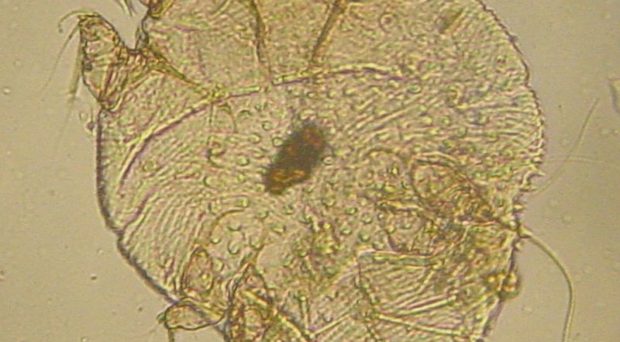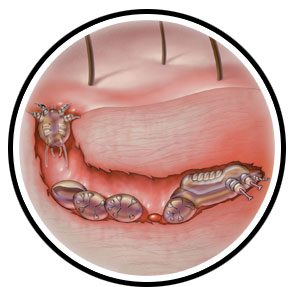
Mites don’t normally provoke good thoughts, but scabies mites are particularly unpleasant for humans. Scabies mites burrow under the skin to feed and lay eggs. Once the larvae hatch, they move to the surface of the skin, mature into adults and find either a new human or a warm spot on the already infected individual to burrow and restart the cycle. These mites are spread between individuals during prolonged close contact, including sexual intercourse.

Scabies is named after the Latin ‘scabo’ to itch. The mites cause itchiness in the skin – particularly at night. Scratching the irritation can lead to impetigo, which is a bacterial skin infection. These infections, often with Staphylococcus aureus and Streptococcus pyogenes, can lead to more severe symptoms, including sepsis. The increasing realization of the global burden of scabies led the WHO to add scabies to its list of neglected tropical diseases in 2017.
Treatment for scabies focuses on control of individuals that display symptoms and their contacts. However, reinfection rates can be high from untreated family or community members. Mass drug administration (MDA) with ivermectin could help reduce community prevalence by treating symptomatic and asymptomatic individuals. This has worked on a small scale, decreasing the prevalence of scabies by 94% one year after treatment. However this was a relatively small population of 2051 people on three islands in Fiji, and it is not known if this affect will be scalable.
MDA campaigns require an immense logistical effort. If multiple diseases and drugs could be co-administered, it would reduce likelihood of treatment fatigue, reduce resources required, and may have a larger net benefit. For example, co-administration of albendazole and praziquantel is frequently used for the treatment of schistosomiasis and soil-transmitted helminthiasis. Administration of ivermectin alongside azithromycin could target scabies and trachoma which co-occur in many locations. In another study by the same research group, the safety of co-administration during MDA was confirmed and there was an absence of serious adverse events.
During this ivermectin and azithromycin trial, the scientists also measured whether this large-scale MDA would have an impact on the prevalence of scabies and impetigo in this population. To achieve this objective, they chose 10 sentinel villages on Choiseul Island (part of the Solomon Islands) to measure the prevalence of scabies and impetigo before MDA with a skin survey. All village members were invited to participate, whereas MDA was available to all residents of the island. At 12 months after the MDA, 4 of the original sentinel villages and 10 new villages were selected for skin surveys. The authors also collected outpatient data from clinics 3 months before and after MDA.
Twelve months after ivermectin and azithromycin MDA, there was an 88% relative reduction in scabies prevalence. Before MDA, nearly 1 in 5 individuals (18.7% prevalence) had scabies whereas one year after MDA, only 1 in 50 individuals had scabies (2.3% prevalence). This significant reduction was found in the four paired sentinel villages and new follow-up villages. Overall, this shows that co-administration of ivermectin and azithromycin can reduce prevalence up to one year after community MDA.
There was also a reduction in the number of individuals visiting clinics in the three months after MDA, particularly for skin related conditions. This suggests that scabies and impetigo are less common, though it is difficult to say whether impetigo is lower because scabies declined or if the azithromycin reduced bacterial infections that are the direct cause. It is likely that both drugs affected the prevalence of impetigo, and likely that impetigo is linked heavily to scabies in the setting as there was a 74% relative reduction one year post MDA, similar to declines observed in scabies.
The results of this study offer hope for the control of scabies. Although these trials have only just started, these significant reductions, especially 1 year out are quite promising. As the authors point out, the efficacy of such campaigns need to be tested across a larger area but the hope is these positive outcomes will remain.

Comments